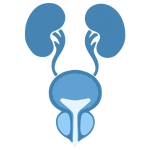Bladder cancer

Bladder cancer (BC) is the seventh most common cancer between males and the eleventh if both genders are considered. Several risk factors are connected with BC. The most important is tobacco smoking accounting for almost 50% of the cases. The occupational exposure that occurs mainly in the paint, dye, metal and petroleum industrial process (substances like aromatic amines, polycyclic aromatic hydrocarbons ect.) is the second most important risk factor. Other factors to be taken in consideration are family history, chlorination and exposure to arsenic of drinking water, personal hair dye (mostly those permanent), ionizing radiation and chronic cystitis (schistosomiasis).
The most common finding is haematuria. Less common may be other symptoms of the lower urinary tract like painful urination, frequency and urgency.
Once bladder cancer is suspected, cystoscopy and histological examination of biopsies taken from suspicious areas or resected tumors must be performed. In selected cases work-up is completed with CT-urography.
BC classification:
- Non muscle invasive bladder cancer (NMIBC). Superficial tumor that doesn’t infiltrate the muscle wall of the organ.
Treatment: Transurethral resection of bladder tumor (TURBT). To control the risk of recurrence and progression of the disease is recommended follow up of patient according to determinate schedule that reflects the individual degree of risk.
- Muscle invasive bladder cancer (MIBC). Infiltrates the muscle wall of the organ.
Treatment : According to disease staging treatment options are:
- Radical cystectomy and urinary diversion:
- Ureterostomy
- Ileal conduit (Bricker technique)
- Orthotopic neobladder
- Chemotherapy
- Radiotherapy


